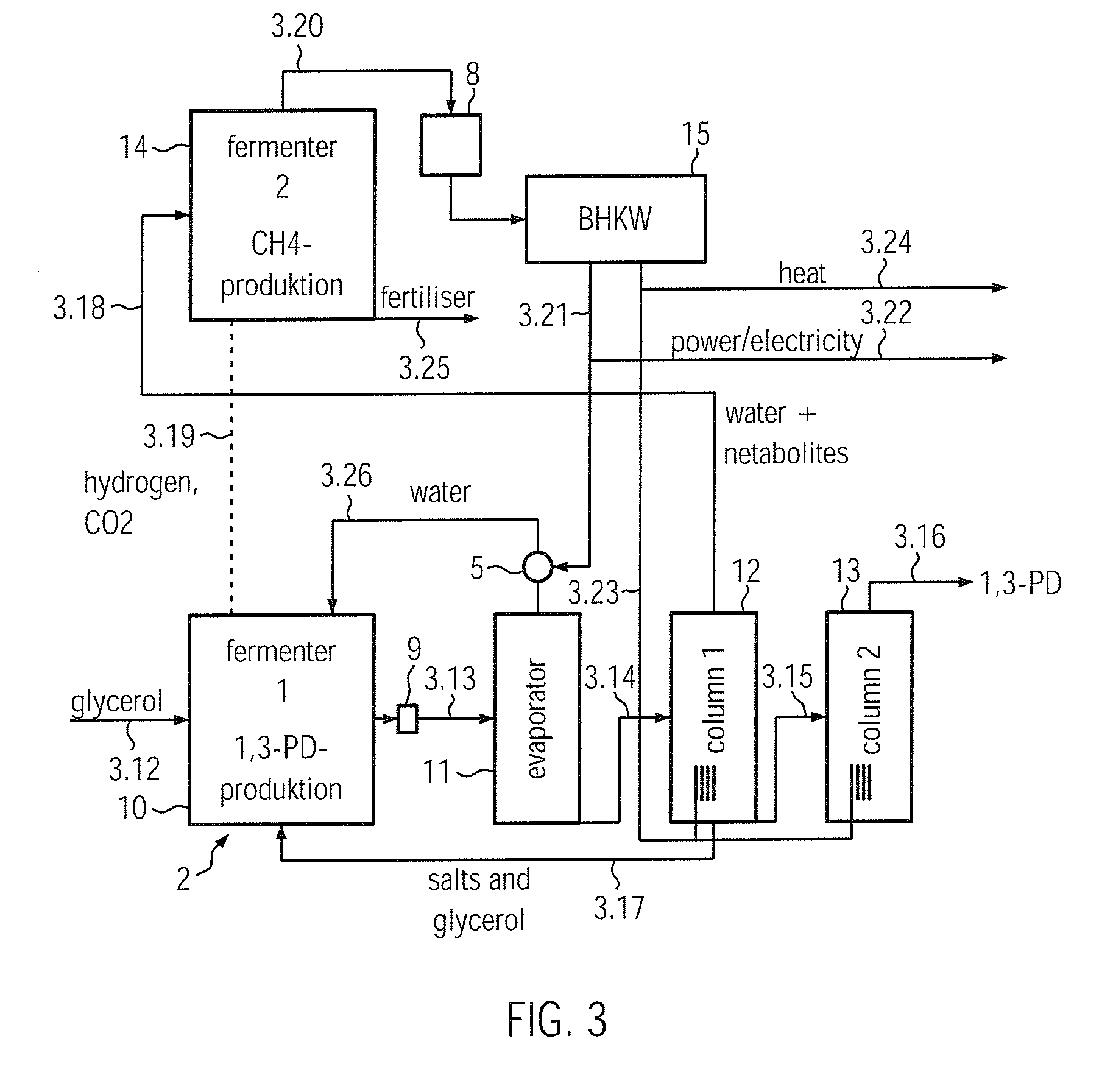Process And Apparatus For The Microbial Production Of A Specific Product And Methane
a technology of microbial production and process, which is applied in the direction of biochemical equipment, biochemical equipment and processes, biofuels, etc., can solve the problem of high energy consumption of the process and other problems
- Summary
- Abstract
- Description
- Claims
- Application Information
AI Technical Summary
Benefits of technology
Problems solved by technology
Method used
Image
Examples
first embodiment
[0032]FIG. 1: a circuit diagram of an apparatus according to the invention for the combined production of 1,3-propanediol and methane,
[0033]FIG. 2: a sectioned view of a bioreactor of the first embodiment according to the invention, cut away at the side,
second embodiment
[0034]FIG. 3: a circuit diagram of an apparatus according to the invention for the combined production of 1,3-propanediol and methane,
[0035]FIG. 4: a block diagram with mass flows,
[0036]FIG. 5: a balance model, and
[0037]FIG. 6: a circuit diagram for the purification of 1,3-propanediol.
1. APPARATUS OF THE FIRST EMBODIMENT
[0038]FIG. 1 shows a preferred embodiment of an apparatus 1 for the combined production of 1,3-propanediol and methane.
[0039]The apparatus 1 has a bioreactor 2. The bioreactor 2 may be divided via a vertically arranged dialysing membrane 2.1 into two reactor chambers 2.2, 2.3 (FIG. 2). It is however also possible to use a bioreactor without a membrane, in which a co-culture of product-forming acetogenic and methanogenic microorganisms is established.
[0040]The dialysing membrane 2.1 may be either hydraulically permeable (e.g. made of PES) or hydraulically impermeable (e.g. PP). The membrane may be built into the reactor 2 or may be in the form of an external direct or...
third embodiment
[0091]So, it is possible in a further third embodiment of the invention to produce 1,3-propanediol and methane in a non-sterile fermentation using a co-culture of 1,3-propanediol producers, acetogenic and methanogenic microorganisms. The 1,3-propanediol producing microorganisms and the acetogenic and methanogenic microorganisms recycling the metabolites may in fact be cultivated at the same pH values and temperatures. The non-sterile conduct of the process makes this co-cultivation fermentation especially advantageous because of its lower cost.
[0092]The bioreactor may be run with relatively short biomass retention times, which means that microorganisms harmful to the process, such as for example sulphate-reducing microorganisms, may be washed out of the bioreactor.
[0093]The substrate is a glycerol solution, for example technical glycerol. The anaerobic 1,3-propanediol producers which grow in the bioreactor produce from the glycerol as metabolism end-products acetic acid, butyric aci...
PUM
| Property | Measurement | Unit |
|---|---|---|
| temperatures | aaaaa | aaaaa |
| pressures | aaaaa | aaaaa |
| reaction temperatures | aaaaa | aaaaa |
Abstract
Description
Claims
Application Information
 Login to View More
Login to View More - R&D
- Intellectual Property
- Life Sciences
- Materials
- Tech Scout
- Unparalleled Data Quality
- Higher Quality Content
- 60% Fewer Hallucinations
Browse by: Latest US Patents, China's latest patents, Technical Efficacy Thesaurus, Application Domain, Technology Topic, Popular Technical Reports.
© 2025 PatSnap. All rights reserved.Legal|Privacy policy|Modern Slavery Act Transparency Statement|Sitemap|About US| Contact US: help@patsnap.com



